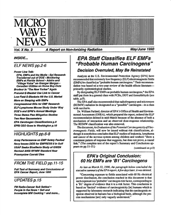News & Comment
Big Score for Industry Scientists
Monday, December 1, 2014
Last updated March 20, 2015
First Federal Agency To Acknowledge Risk Soon Backs Down
Saturday, August 16, 2014
Last updated January 1, 2016
Large Study Shows Recent, But Not Lifetime, Exposures Lead to Brain Tumors

Monday, June 30, 2014
Last updated June 9, 2017
Featuring Dan Krewski, the Royal Society and Health Canada

Wednesday, April 23, 2014
Last updated February 26, 2021
Industry Treads Water; Conflicts Abound
Tuesday, February 25, 2014
Last updated February 27, 2014

